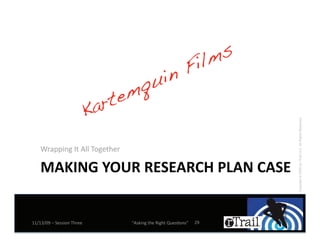Kartemquin Executive Summary Draft
- 1. Copyright © 2009 by rTrail LLC. All Rights Reserved. 0..',% 2 ** -%20
- 2. VVJVXJU^ L 11'-, 0 P 1)',% 2 '%2 914-,1P W^
- 3. 6304 3((-7 90 WUVU 10 *, K -*1 - M *:,2 9',1 +%0= M -2,4* 9,01 *9 Copyright © 2009 by rTrail LLC. All Rights Reserved. Copyright 2009 b rTra LLC. All Rights Re ved Reserved 2 `A M 0'%%01 :,9 M 0':1 -,,4:'2= 2- 1 9'* Trail = = 0, Copyright M = -', 90 -++9,'2= M 0 -9%2 01 VVJVXJU^ L 11'-, 0 P 1)',% 2 '%2 914-,1P XU
- 4. 6304 3((-7 90 WUVU 10 *, K 4-,1 12 0%21 V W X M *9 2- 1 M ' - 2 0' Copyright © 2009 by rTrail LLC. All Rights Reserved. Z W -4:4-,1 V Z M -9+,20'1 M = 60 X Y VVJVXJU^ L 11'-, 0 P 1)',% 2 '%2 914-,1P XV
- 5. 6304 3((-7 90 WUVU 10 *, K +.2 M = 1%+,2 - M 0-1.21 -,1 Copyright © 2009 by rTrail LLC. All Rights Reserved. M ,,*1 *91 ',)1 M 11%1 2
- 6. 0, M 0'-0'41 , M .,,'1 VVJVXJU^ L 11'-, 0 P 1)',% 2 '%2 914-,1P XW
- 7. -; ' '+ 2 H 0IA Copyright © 2009 by rTrail LLC. All Rights Reserved. *11 04'.4-, -+;-0) 0%,'4-, *'%,+,2 VUJWJU^ L 11'-, , P 1)',% 2 '%2 914-,1P XX
- 8. I=$/ #+. - %) (7 JHIH -0)# ') /$/ . (7 3%) ) '': +-12 '+.-02,2 9', -0 2 WUVU +0)4,% .*, 2- 010B 9,012, , 011 '1 .-2,4* 9,01 ;- : 2 ',-+ , ',*',4-, 2- -+ +(-0B -,1'12,2 -,-01 2-
- 9. 02+/9', 1 , -0%,'4-,B 020 2, (912 -90 ',':'9* *+1E
- 10. 02+/9',G1 +0)4,% .0-*+ '1 22 +,= ':01 9',1 ),-; -90 *+1B 92 - ,-2 ),-; -90 -0%,'4-,E 0 -0 ; 0 *--)',% 2 )=B 1+** %0-9. ;- 19..-02 2 2)*',% - 1-'**= .0-%011': '1191 20-9% 2 021 , ', *+ ', .049*0B %-',% =-, , ..0- 22 20%21 ',':'9* :';01 J .-2,4* 9,01 ;- += : .049*0 ',2012 ', 2 1.' 19(2 +60 - -, - -90 *+1E 90 +(-0 010 /914-, '1 2- 1) ;2 +-4:21 21 -,-01 2- -+ 6 2- ,-,.0-21 J ;2 :*9 '1 20 -0 2+ ', ',% +(-0 9,0 -0 , 021 -0%,'4-,A 1 +(-0 -,-01 , 9,',% -'1 +912 011 20-9% +0)4,% .*, 22 -,,21
- 11. 02+/9',G1 H',9120= *0I 12291 , 9,'/9 91',11 +-* ) 2- -0%,'4-,* 9,',%E -2,4* 9,01 , 2- + +-0 ;0 - -; -90 -0%,'4-, ;-0)1 , -; -90 *+1 0 -,':B .0-9 , '120'92 20-9% -++9,'2= .0-11E Copyright © 2009 by rTrail LLC. All Rights Reserved. J= $/ -.-$ (/$*. 5*3' ''*5 ( /* ?$-@ /$ ).5-.: 2 '1 += -,2,4-, 22 2 12 010 +2-1 2- , -92 -92 2'1 9', ;-9* 20-9% VDV ',204-,1 , -91 %0-9.1 22 0 11+* 20-9% , ',:'24-,* .0-11E '1 , -, 20-9% ','44:1 22 **-; 21 %0-9.1 2- * +-0 *') 12)-*01 ', 2 .0-11 = ',:'4,% 2+ 2- 2) .02 ', 4:'41 22 0 *0= .02 - ;2
- 12. 02+/9', -1B 19 1 6,',% -90 H -++9,'2= 0,',%1I N;0 -90 -++9,'2= - 12! , 11-'21 -!0 - *++)01 0 ) -, 2'0 ;-0)1K',K.0-%011OB , ', .049*0 = -!0',% 2+ 2 , 2- 6, H,) 0:';1I - -90 -;, ;-0)1K',K.0-%011 1 2= 0 -0+ L .0.1 1 .02 - ,1,2 1910'.4-,J++01'. .0-%0+E %-* ;-9* 2- 010 2'1 9', ;'* *1- +)',% 2+ * .02 - -90 -++9,'2=E VVJVXJU^ L 11'-, 0 P 1)',% 2 '%2 914-,1P XY
- 14. 02+/9', '*+1 9*'24: 10 ..0- EI EI .-$ /$* $* .: -%/-% *- *5 . -0)# 3.0*) '0*) /$ ..3 3.0*) 2 2 :*9 ,K.2 900,2 VO : H2 .-2,4* 2- 9',1 - ,20:'; J .20-,1 , -+ ;-9* Copyright © 2009 by rTrail LLC. All Rights Reserved. N 9,01O 2- 0.01,2 2- -91 %0-9. ,-,K.20-,1 +(-0 +) =-9 ),-; 91 , += .-2,4* 9,0 ;,2 2- -90 :*9B 9',A WO 900,2 .02 - -,-0 2- ,-2 (912 -90 -20 ,-,K -90 ',':'9* .0-2 021 %0-9.AI *+1 -0% XO 6, V :,2 ;'2 -90 %0-9. VVJVXJU^ L 11'-, 0 P 1)',% 2 '%2 914-,1P XZ
- 16. -/(,3%) %'(. EI 3.%).. ..3 H 2- ',01 0, ;0,11I $7 '%4 /$%. 9',1 ),-; -90 *+1B 92 ,-2 -90 -0%,'4-,E 5 3%) -#/ K= 20%2 '1 '!0,2 0-+ += -0 9 2- 2 -**-;',% *+,21D Copyright © 2009 by rTrail LLC. All Rights Reserved. I= % ./# • ) A#-3/.; J= % ./7' A -.*)'%/7 • )0)#A-./B0( $*( 37-; .%)#'A)5'75 K= 04%0. A $4%*- • %#$ %)/-)/ 3.; 5/$ '(. -#3'-'7; *) '*/. * (%' '%./. L= '% '3. • %-'; 04%./; +*'7(/$. VVJVXJU^ L 11'-, 0 P 1)',% 2 '%2 914-,1P X[
- 18. 02+/9', '*+1 -,19+0 10 *, EI .-$ 3.0*) /$**'*#%. • -; , ;= - 9',1 9,424: 9*'24: , 91A Copyright © 2009 by rTrail LLC. All Rights Reserved. '2 90:= ,2012 2,-%0.= 90:= VVJVXJU^ L 11'-, 0 P 1)',% 2 '%2 914-,1P X





































